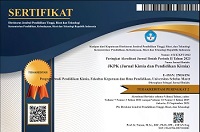Online Eye-Tracking: Observing the Attention of Pre-service Chemistry Teacher from Non-Science Backgrounds in Solving Chemistry Problems
Abstract
Recent advances in online eye-tracking allow researchers to capture eye movements as visible markers of attentional processes. This study adopts a mixed-methods design using webcam-based eye tracking via the RealEye platform to profile the attentional patterns of pre-service chemistry teachers who completed non-science tracks in high school. Two participants from the Chemistry Education program at UIN Antasari Banjarmasin undertook a problem-solving task in chemistry; their eye movements were recorded and analyzed descriptively. In framing attention, we distinguish between overt orientation—shifts in gaze toward a target—and covert orientation—mental shifts of focus without corresponding eye movements. Findings indicate that both participants required a comparatively longer time to observe, read, and solve the given problems. These attentional profiles align with their problem-solving outcomes, which fell into the medium and low performance categories. The results suggest that a non-science secondary background may be associated with less efficient visual strategies when tackling chemistry tasks. Targeted instructional support—such as scaffolded practice with chemical representations and stepwise problem decomposition—may therefore be warranted in teacher-education curricula.
Keywords
Full Text:
PDFReferences
[1] E. Susilawati, I. Hamidah, N. Rustaman, and W. Liliawati, “Problem Solving Learning in Science Education: A Systematic Literature Review,” Jurnal Penelitian Pendidikan IPA, vol. 10, no. 8, Art. no. 8, Aug. 2024, doi: 10.29303/jppipa.v10i8.5033.
[2] D. Keller and J. Hermanns, “Development of a self‑test for undergraduate chemistry students: how do students solve tasks on basic content knowledge?,” Chemistry Teaching International, vol. 6, no. 1, pp. 65–75, Mar. 2024, doi: 10.1515/cti‑2023‑0068.
[3] K. Muna and M. Bahit, “Eye‑tracking and metacognitive skills: A review on the use of eye‑tracking for measuring students’ metacognitive skills in chemistry learning,” Journal of Physics: Conference Series – The 1st International Conference on Mathematics, Science and Computer Education, vol. 1422, no. 1, p. 012033, Jan. 2020, doi: 10.1088/1742‑6596/1422/1/012033.
[4] O. R. Anderson, B. C. Love, and M.‑J. Tsai, “Neuroscience Perspectives for Science and Mathematics Learning in Technology‑Enhanced Learning Environments,” International Journal of Science and Mathematics Education, vol. 12, no. 3, pp. 467–474, Jun. 2014, doi: 10.1007/s10763‑014‑9540‑2.
[5] Y.‑C. Chen and F.‑Y. Yang, “Probing The Relationship Between Process Of Spatial Problems Solving And Science Learning: An Eye Tracking Approach,” International Journal of Science and Mathematics Education, vol. 12, no. 3, pp. 579–603, Jun. 2014, doi: 10.1007/s10763‑013‑9504‑y.
[6] K. L. Havanki and J. R. VandenPlas, “Eye Tracking Methodology for Chemistry Education Research,” in ACS Symposium Series, D. M. Bunce and R. S. Cole, Eds., Washington, DC: American Chemical Society, 2014, vol. 1166, pp. 191–218, doi: 10.1021/bk‑2014‑1166.ch011.
[7] M.‑L. Lai et al., “A review of using eye‑tracking technology in exploring learning from 2000 to 2012,” Educational Research Review, vol. 10, pp. 90–115, Dec. 2013, doi: 10.1016/j.edurev.2013.10.001.
[8] J. Peterson, Z. Pardos, M. Rau, A. Swigart, C. Gerber, and J. McKinsey, “Understanding Student Success in Chemistry Using Gaze Tracking and Pupillometry,” in Artificial Intelligence in Education, C. Conati, N. Heffernan, A. Mitrovic, and M. F. Verdejo, Eds., Cham: Springer International Publishing, 2015, pp. 358–366, doi: 10.1007/978‑3‑319‑19773‑9_36.
[9] V. M. Williamson, M. Hegarty, G. Deslongchamps, K. C. I. Williamson, and M. J. Shultz, “Identifying Student Use of Ball‑and‑Stick Images versus Electrostatic Potential Map Images via Eye Tracking,” Journal of Chemical Education, vol. 90, no. 2, pp. 159–164, Feb. 2013, doi: 10.1021/ed200259j.
[10] M.‑H. Yen and F.‑Y. Yang, “Methodology and Application of Eye‑Tracking Techniques in Science Education,” in Science Education Research and Practices in Taiwan: Challenges and Opportunities, M.‑H. Chiu, Ed., Singapore: Springer, 2016, pp. 249–277, doi: 10.1007/978‑981‑287‑472‑6_13.
[11] M. Tóthová, M. Rusek, and V. Chytrý, “Students’ Procedure When Solving Problem Tasks Based on the Periodic Table: An Eye‑Tracking Study,” Journal of Chemical Education, vol. 98, no. 6, pp. 1831–1840, Jun. 2021, doi: 10.1021/acs.jchemed.1c00167.
[12] S. W. Locatelli, L. S. de Oliveira, R. da S. S. Junior, and J. R. Sato, “Perspectives of the Eye‑Tracking Application to Understand Access to Representational Levels in Chemistry,” Journal of Science Education and Technology, 2024, doi: 10.1007/s10956‑024‑10123‑x.
[13] A. P. Sidhawara, S. Wibirama, and D. J. Suroso, “Kajian Eye‑Tracking Pengaruh Gender Terhadap Proses Kognitif dalam Pembelajaran Multimedia,” Jurnal Edu..., vol. 12, 2023. (Ensure to include full journal name if available.)
[14] M. Pietrzak, F. Żarnowiec, and D. Sromek, “RealEye Webcam Eye‑Tracking for Computers (Technology White Paper),” RealEye sp. z o.o., White Paper 1, v. 2.0.0, Aug. 2024, www.realeye.io.
[15] A. A. Taim, S. Tiatri, and J. T. Beng, “Gazerecorder: Mengamati Atensi Pada Siswa Sekolah Menengah Atas Menggunakan Eye Tracker,” Jurnal Muara Ilmu Sosial, Humaniora dan Seni, vol. 6, no. 2, Art. no. 2, 2022, doi: 10.24912/jmishumsen.v6i2.13558.2022.
[16] H. Türkoğlu and S. Yalçınalp, “Investigating problem‑solving behaviours of university students through an eye‑tracking system using GeoGebra in geometry: A case study,” Education and Information Technologies, Feb. 2024, doi: 10.1007/s10639‑024‑12452‑1.
[17] M. Andrzejewska et al., “Eye‑tracking verification of the strategy used to analyse algorithms expressed in a flowchart and pseudocode,” Interactive Learning Environments, Nov. 2016. [Online]. Available: https://www.tandfonline.com/doi/full/10.1080/10494820.2015.1073746. (Accessed: Jul. 22, 2025.)
[18] “Participant Quality Stats Explained | Knowledge Base | RealEye.io,” Participant Quality Stats Explained. [Online]. Available: https://support.realeye.io/participant-quality-stats-explained/. (Accessed: Sep. 11, 2024.)
[19] N. Chettaoui, A. Atia, and M. S. Bouhlel, “Student Performance Prediction with Eye‑Gaze Data in Embodied Educational Context,” Education and Information Technologies, vol. 28, no. 1, pp. 833–855, Jan. 2023, doi: 10.1007/s10639‑022‑11163‑9.
[20] G. Knoblich, S. Ohlsson, and G. E. Raney, “An eye movement study of insight problem solving,” Memory & Cognition, vol. 29, no. 7, pp. 1000–1009, Oct. 2001, doi: 10.3758/BF03195762.
[21] M. Sajka and R. Rosiek, “Solving a problem by students with different mathematical abilities: A comparative study using eye‑tracking,” in CERME 9 – Ninth Congress of the European Society for Research in Mathematics Education, K. Krainer and N. Vondrová, Eds., Prague, Czech Republic: Charles University in Prague, Faculty of Education and ERME, Feb. 2015, pp. 1752–1758. [Online]. Available: https://hal.science/hal-01288030. (Accessed: Sep. 11, 2024.)
[22] M. Dobias, J. Dolezal, V. Chytrý, A. Klesalová, P. Kozelka, and J. Černohous, “Determining a strategy for problem solving based on eye movements,” Ad Alta Journal of Interdisciplinary Research, vol. 7, pp. 26–27, Sep. 2017.
[23] S. Negi and R. Mitra, “Fixation duration and the learning process: an eye tracking study with subtitled videos,” Journal of Eye Movement Research, vol. 13, no. 6, p. 10.16910/jemr.13.6.1, doi: 10.16910/jemr.13.6.1.
[24] Á. Bartalis, I. Péntek, and I. Zsoldos‑Marchiș, “A Pilot Study on Investigating Primary School Students’ Eye Movements While Solving Compare Word Problems,” Open Education Studies, vol. 5, no. 1, p. 20220207, Nov. 2023, doi: 10.1515/edu‑2022‑0207.
[25] I. I. Salame, A. Montero, and D. Eschweiler, “Examining some of the students’ challenges and alternative conceptions in learning about acid‑base titrations,” International Journal of Chemistry Education Research, vol. 6, no. 1, pp. 1–10, Apr. 2022, doi: 10.20885/ijcer.vol6.iss1.art1.
[26] N. P. Timilsena, K. B. Maharjan, and K. M. Devkota, “Teachers’ and students’ experiences in chemistry learning difficulties,” Journal of Positive School Psychology, vol. 6, no. 10, pp. 2856–2867, 2022.
[27] Webmaster, “Eye‑Tracking for Diverse and Advanced Learning Techniques in Chemistry Education,” Innovative Learning Center. [Online]. Available: https://ilearningcenter.education/eye-tracking-for-diverse-learning-advanced-learning-techniques-in-chemistry-education/. (Accessed: Sep. 11, 2024.)
Refbacks
- There are currently no refbacks.








